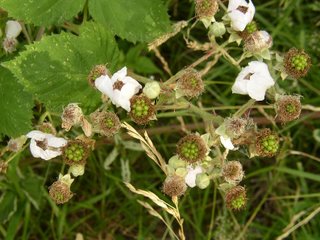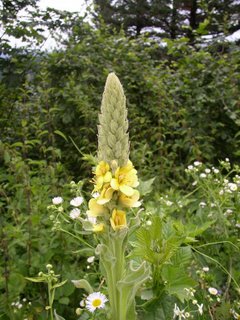Oregon Pictures
I'll have some new pictures to go through tonight (I hiked around Gibson Jack today, without getting lost or losing the trail), but these are the last ones I'm likely to post from my jaunt northwest. This is probably wild blackberry. At least, blackberries have thorns, and there's a thorn visible. However, there are tons of berries that grow wild in Oregon, so I'm not 100% sure.
This is probably wild blackberry. At least, blackberries have thorns, and there's a thorn visible. However, there are tons of berries that grow wild in Oregon, so I'm not 100% sure. Yes, I've posted this one before, but not with a striped caterpillar on it! :^D Curly-cup gumweed. Which (different source from last time) was used as an antispasmodic, and from which medicines for asthma have been extracted [Plants of the RM]
Yes, I've posted this one before, but not with a striped caterpillar on it! :^D Curly-cup gumweed. Which (different source from last time) was used as an antispasmodic, and from which medicines for asthma have been extracted [Plants of the RM] Canadian thistle (which apparently is NOT a Canada native), aka Creeping thistle aka cirsium arvens. Random trivia [Plants of the RM]: creeping thistle is the only thistle in the Rockies to have either male or female plants.
Canadian thistle (which apparently is NOT a Canada native), aka Creeping thistle aka cirsium arvens. Random trivia [Plants of the RM]: creeping thistle is the only thistle in the Rockies to have either male or female plants.
 After much staring at pictures, I'm pretty sure these are both self-heal, aka heal-all, aka Prunella vulgaris. There's a similar flower, American dragonhead, but it seems to prefer dry areas. It was quite moist where I found these. I think the first one was on Sauvie Island and the second was on our waterfall tour. Anyway, selfheal is supposed to make a nice, refreshing tea, and have lots of medicinal properties [Plants of the RM].
After much staring at pictures, I'm pretty sure these are both self-heal, aka heal-all, aka Prunella vulgaris. There's a similar flower, American dragonhead, but it seems to prefer dry areas. It was quite moist where I found these. I think the first one was on Sauvie Island and the second was on our waterfall tour. Anyway, selfheal is supposed to make a nice, refreshing tea, and have lots of medicinal properties [Plants of the RM]. I can't find this in my books, but I know exactly what it is: sweet pea. It could be Common Vetch, Vicia sativa. That's the closest match I can find. It could also be a cultivated variety that "escaped." I see sweetpea growing up people's fences as an ornamental flower sometimes. Pretty, but it doesn't produce very good peas.
I can't find this in my books, but I know exactly what it is: sweet pea. It could be Common Vetch, Vicia sativa. That's the closest match I can find. It could also be a cultivated variety that "escaped." I see sweetpea growing up people's fences as an ornamental flower sometimes. Pretty, but it doesn't produce very good peas. Well, these are definitely in the lily family. That much I'm sure of. I've found similar ones in my books, but nothing that I'd call a match. Red Lily aka Wood Lily aka Lillium philadelphicum, has the right shape and color, but is supposed to have "purple spots" in its yellow center. So it may be a spotless variety of that. *shrugs*
Well, these are definitely in the lily family. That much I'm sure of. I've found similar ones in my books, but nothing that I'd call a match. Red Lily aka Wood Lily aka Lillium philadelphicum, has the right shape and color, but is supposed to have "purple spots" in its yellow center. So it may be a spotless variety of that. *shrugs* In the background is some fleabane, and maybe a raspberry plant, but the center stalk is mullein. It's a biennial. The first year, it just produces a rosette of fuzzy leaves. The next year, the flower stalk grows. Oh, and if you're ever out of toilet paper, mullein leaves are often recommended as a wilderness substitute. They are quite soft and fuzzy.
In the background is some fleabane, and maybe a raspberry plant, but the center stalk is mullein. It's a biennial. The first year, it just produces a rosette of fuzzy leaves. The next year, the flower stalk grows. Oh, and if you're ever out of toilet paper, mullein leaves are often recommended as a wilderness substitute. They are quite soft and fuzzy. Last one is Common Evening Primrose, Oenothera villosa ssp. strigosa. Whoa. Idaho Mountain Wildflowers says that the blooms last less than a day. Guess I lucked out. Oh, and that "ssp." in the scientific name seems to mean "subspecies".
Last one is Common Evening Primrose, Oenothera villosa ssp. strigosa. Whoa. Idaho Mountain Wildflowers says that the blooms last less than a day. Guess I lucked out. Oh, and that "ssp." in the scientific name seems to mean "subspecies".




No comments:
Post a Comment